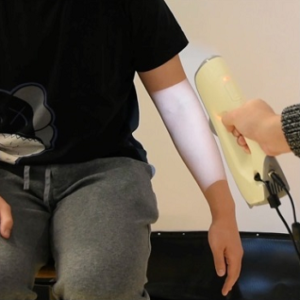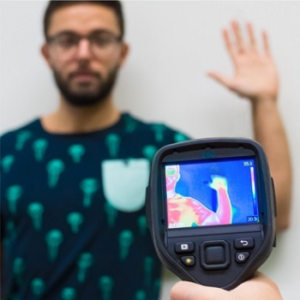 Traditional plaster casts for broken bones are not much fun at all, unless you’re a kid and can ask all of your friends to sign it in a rainbow of colors…even then, I imagine the luster wears off fast. These casts, while very important as they support and protect the healing bone, are bulky and time-consuming to apply, and forget about taking a normal shower – they’re not really waterproof. Plaster casts also don’t offer a lot of breathing room for your skin, which can lead to irritation and overheating.
Traditional plaster casts for broken bones are not much fun at all, unless you’re a kid and can ask all of your friends to sign it in a rainbow of colors…even then, I imagine the luster wears off fast. These casts, while very important as they support and protect the healing bone, are bulky and time-consuming to apply, and forget about taking a normal shower – they’re not really waterproof. Plaster casts also don’t offer a lot of breathing room for your skin, which can lead to irritation and overheating.
Casts made with 3D printing technology can help with a lot of these issues – we’ve seen 3D printed casts that are ventilated and water-safe, casts with embedded sensors to track healing, and even 3D printed casts that be signed through social media sites.
 A team of faculty researchers from Delft University of Technology (TU Delft) and Boston University have developed a process for making 3D printed orthopedic casts that are personalized to the patient, as well as offering a unique thermal-comfort design.
A team of faculty researchers from Delft University of Technology (TU Delft) and Boston University have developed a process for making 3D printed orthopedic casts that are personalized to the patient, as well as offering a unique thermal-comfort design.
The 3D printed orthopedic cast still protects and supports the broken bone as it heals, but for the first time takes into account thermal comfort and mechanical stability. The team worked to improve air circulation in the casts where skin has a high sensitivity to heat, creating a product that is still strong but is more comfortable for heat-sensitive skin…a quality that plaster casts are sorely lacking.
“I think this is the first result in this area that takes thermal comfort into account. These personalised plaster connections from the 3D printer provide much more natural support, which offers patients more comfort through optimal air circulation. This can also help the healing process,” said Professor Charlie Wang, an Advanced Manufacturing professor in the Design Engineering Department of TU Delft’s Industrial Design Engineering (IDE) school.
“However, we are still in the prototype phase, testing in a medical environment must still happen.”
While the team’s cast isn’t quite ready for the mass medical market, they did publish a paper on their work, titled “Thermal-Comfort Design of Personalized Casts,” which they presented at last week’s ACM Symposium on User Interface Software and Technology (UIST) in Quebec City; co-authors include Xiaoting Zhang, Guoxin Fang, Chengkai Dai, Jouke Verlinden, Jun Wu, Emily Whiting, and Wang.
The abstract reads, “This paper introduces a novel method for designing personalized orthopedic casts which are aware of thermal-comfort while satisfying mechanical requirements. Our pipeline starts from thermal images taken by an infrared camera, by which the distribution of thermal-comfort sensitivity is generated on the surface of a 3D scanned model. We formulate a hollowed Voronoi tessellation pattern to represent the covered region for a web-like cast design. The pattern is further optimized according to the thermal-comfort sensitivity calculated from thermal images. Working together with a thickness variation method, we generate a solid model for a personalized cast maximizing both thermal comfort and mechanical stiffness. To demonstrate the effectiveness of our approach, 3D printed models of personalized casts are tested on body parts of different individuals.”
Thermal comfort is a sensation that describes how one feels about their body’s thermal state, and according to the paper, this can be improved by “customizing the air-exposure of skin in regions with high thermal sensitivity,” which results in less infections and skin irritation. The researchers determined that adding air holes to the casts were the optimal way to achieve this.
Heat sensitivity is not the same for everyone, so the personalized, 3D printed cast process begins with 3D scanning the part of the body that requires a cast; the researchers used an Artec Eva. Then, an infrared camera, such as the FLIR E60 used by the team, analyzes the heat sensitivity of the person’s skin; this data is then processed and used to form a 3D printable structure that’s not unlike a net.
The researchers used PLA material to print test casts, in a Hollowed Voronoi Tessellation, on an Ultimaker 3D printer, which were then heat-tested in two separate environments – a regular office and a sauna room – for 30 minutes.
The distribution and size of the air holes for the cast are determined from the skin’s heat sensitivity in the scanned area; in addition, doctors will also need to take into account the forces acting on the cast when trying to calculate where the air holes should go.
Areas of the skin that have a high heat sensitivity require larger air holes, so the cast would need to be slightly thicker in those parts to make sure it’s strong everywhere. This results in a comfortable, lightweight, and waterproof cast that can still offer optimal support to a damaged body part.
Join the discussion of this and other 3D printing topics at 3DPrintBoard.com, or let us know your thoughts in the Facebook comments below.
[Source/Images: TU Delft]
Subscribe to Our Email Newsletter
Stay up-to-date on all the latest news from the 3D printing industry and receive information and offers from third party vendors.
You May Also Like
NSF Awards Kentucky $1M for Advanced Manufacturing
The National Science Foundation has awarded a $1 million grant to the University of Louisville for the Advancing Manufacturing and Building Construction Technologies (NSF AMT) project. This initiative is part...
3D Printing News Briefs, May 11, 2024: 3D Printed Stent, Tower, Sculptures, & More
We’re starting off with medical research in today’s 3D Printing News Briefs, as researchers in Korea used CT images and 3D printing to fabricate an educational simulator for a mastoidectomy....
3D Printing Unpeeled: Wind Turbines, Probiotics and Lenses
TPI Composites, ORNL and Ingersoll Rand are working to make wind turbine tooling segments that can be 18.3 meters long. These elements also include resistive wires that help keep the...
Tethon 3D Releases Cost-effective Bioprinter
Tethon 3D, known for its ceramic-loaded DLP materials, custom resins, and DLP 3D printers, has recently released a bioprinter. Vat polymerization printers like DLP systems have been widely used by...



































